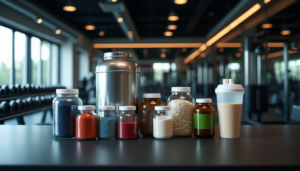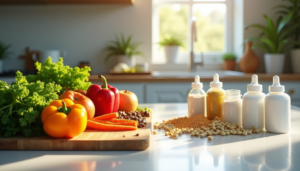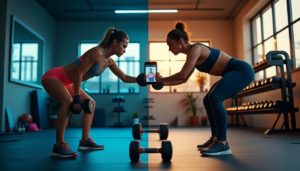The FDA reports more than three-quarters of Americans depend on dietary supplements today. This raises a crucial question: should we get our vitamins from food or supplements? Store shelves and online marketplaces overflow with nearly 100,000 supplement products, yet only a small number have undergone rigorous safety and effectiveness testing.
Getting vitamins from food versus supplements presents a complex choice. Health conditions, medications, and poor diet quality make it hard for many people to obtain adequate nutrients naturally. Research reveals that natural food sources of vitamins A, K, zinc, and magnesium reduce mortality risks, but excessive calcium supplementation can increase cancer-related death risks.
This piece will show why traditional food sources might fall short today. We’ll get into the evolving supplement market and guide you through smart nutrition choices for 2025 and beyond.
The Changing Nutritional Value of Modern Foods
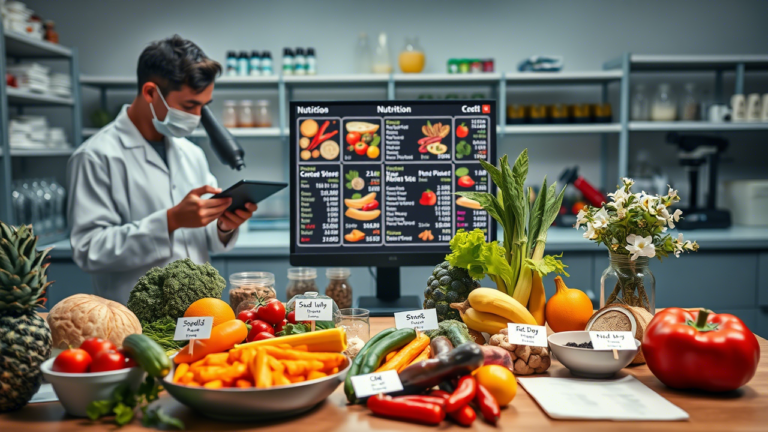
The fruits and vegetables on your plate today might look similar to what your grandparents ate, but research shows they’re quite different when it comes to nutrition. Modern farming methods and food systems have changed how nutritious our food supply is. This makes the question of is it better to get vitamins from food or supplements more complicated than ever.
Soil depletion and its effect on nutrient density
Our intensive agricultural practices have substantially depleted soil nutrients worldwide. A landmark study published in the Journal of the American College of Nutrition found “reliable declines” in protein, calcium, phosphorus, iron, riboflavin, and vitamin C in 43 different fruits and vegetables between 1950 and 1999. The Kushi Institute’s analysis of nutrient data from 1975 to 1997 revealed even bigger drops. Fresh vegetables lost 27% of their calcium, 37% of iron, 21% of vitamin A, and 30% of vitamin C.
Mineral depletion in soil now affects about 130 million hectares globally – roughly 8% of all cropland. These nutrient-poor soils produce crops with lower nutritional value. Here’s a startling fact: you’d need to eat eight oranges today to match the Vitamin A content of just one orange from your grandparents’ time.
How processing methods affect vitamin content
Food preparation reduces nutrient content even after harvest. Heat processing hits water-soluble vitamins particularly hard. Vitamin C easily breaks down from heat, light, and oxygen exposure – losing 15-55% during cooking and 10-90% during canning. B vitamins (B1, B2, B5, and B9) also decrease with cooking.
Every step from field to plate – trimming, processing, cooking, and storage – reduces nutrient content. Some processes can help though. Breaking down cell walls sometimes makes certain compounds like carotenoids easier to absorb. This adds another layer to the debate about getting vitamins from food vs supplements.
Climate change and crop nutrient levels
Rising CO2 levels pose a serious threat to food’s nutrient density. Crops grown in high CO2 environments show 3-17% lower zinc, iron, and protein content. Scientists project that by 2050, atmospheric changes will reduce global nutrient availability substantially – protein by 19.5%, iron by 13.6%, and zinc by 14.6%.
Climate change’s effects reach beyond these nutrients. Research shows elevated CO2 levels systematically reduce calcium, phosphorus, potassium, sulfur, magnesium, and other minerals in crops of all types. Non-legume plants feel these changes most strongly, which makes having diverse food sources more important than ever.
The rise of ultra-processed foods in daily diets
Ultra-processed foods now rule modern diets. They make up 57.9% of dietary energy for American adults and reach nearly 80% in groups with the highest consumption. American households get more than three-quarters of their food energy from highly processed foods.
This dietary shift brings major nutritional consequences. People who eat more ultra-processed foods tend to consume more sugars, total fats, and saturated fats. They also get less fiber, protein, potassium, zinc, magnesium, and vitamins A, C, D, E, B12, and niacin. Research in The BMJ links ultra-processed foods to over 30 health conditions.
These changes in our food supply explain why many people remain undernourished despite looking well-fed. This makes us think over what is an advantage of consuming natural foods instead of dietary supplements in today’s nutritional world.
Why Getting Vitamins From Food Is Becoming Harder
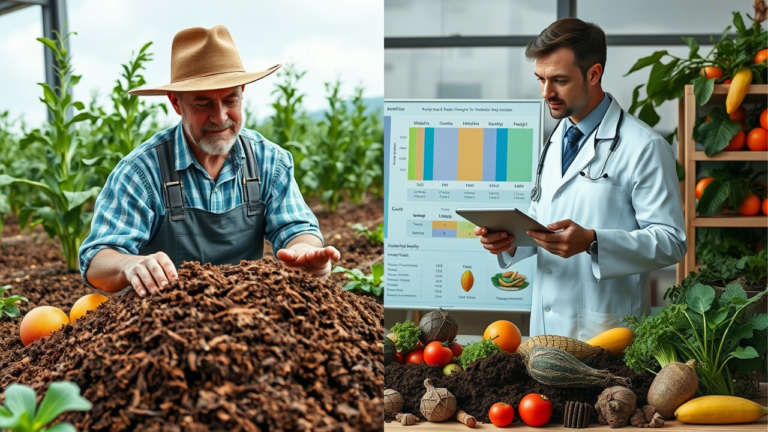
Getting essential nutrients from daily meals has become harder than ever in 2025. The food’s path from farm to plate takes longer and has grown more complex. This creates many chances for nutrients to break down along the way. People often ask is it better to get vitamins from food or supplements to meet their nutritional needs.
Longer food supply chains and nutrient degradation
Food supply chains have grown dramatically. Days or even weeks pass between harvest and when we eat the food. This extended timeline substantially affects nutritional content. Water-soluble vitamins like vitamin C break down easily. They lose 15-55% during cooking and 10-90% during canning.
Vitamins naturally deteriorate during storage. You can see this in how vitamin C levels drop in stored potatoes. Temperature, moisture, oxygen, pH, and other nutrients affect how stable vitamins remain, especially water-soluble ones.
Foods exposed to high heat, light, or oxygen lose the most nutrients. Longer supply chains mean greater risks of nutrient loss. This makes a strong case for getting vitamins from food vs supplements that skip these breakdown processes.
Agricultural practices prioritizing yield over nutrition
A fundamental change to industrial farming has altered our food’s nutritional value. Mass production often uses single-crop farming. This limits soil nutrient diversity and affects how many nutrients crops contain.
Modern farming focuses on quantity rather than quality. This has led to one-third of the world’s soils becoming degraded. Today’s crops have less calcium, iron, vitamin C, and protein than they did in the past.
Farmers get paid based on crop weight above everything else. This spreads existing soil nutrients too thin across too many plants. Crops grown this way might not give us the nutrition we need. This raises questions about which is the best way to meet your vitamin needs through diet or supplements.
Lifestyle factors limiting diverse food intake
Our modern way of life creates real barriers to good nutrition. The Western diet lacks several key nutrients.
TV watching, poor sleep, and drinking alcohol make us eat more without thinking. Alcohol has the strongest effect on increasing food intake. These habits lead to weight gain and make it harder to control what we eat.
These patterns strengthen our brain’s reward response to food cues. This makes unhealthy foods more tempting. Studies show that watching TV not only makes us eat more but pushes us toward foods high in calories and low in nutrients.
Scientists call this combination an “obesogenic lifestyle.” It leaves our brains vulnerable to an environment that promotes obesity. This explains why many people still lack proper nutrients despite having plenty of food available. They consume more than deficiency levels but less than recommended amounts.
These challenges make understanding what is an advantage of consuming natural foods instead of dietary supplements more complex. Both sources now play key roles in today’s nutrition.
The Evolution of Dietary Supplements in 2025

The dietary supplement industry has seen a remarkable transformation by 2025. The global market should reach USD 300 billion by 2028. This development goes way beyond the reach and influence of filling nutritional gaps—it’s changing how we consume supplements and their effectiveness.
New delivery systems beyond pills and powders
Traditional capsules and tablets no longer dominate the market. Gummies have changed the vitamin industry with their pleasant taste but don’t handle high nutrient loads well. Manufacturers responded by creating groundbreaking alternatives like FZZR. This versatile format works as a fizzy beverage, can be chewed, or melts on the tongue with a “buzzy” effect. A single sachet holds 40-50% more active ingredients than typical gummies.
The market now features oral strips with 60% fewer fillers than average capsules. Shot-size liquid supplements have replaced bulky 32-ounce bottles. Natural sugar-free konjac plant-based solid jellies offer another option. These breakthroughs tackle “pill fatigue” and help people keep taking them through enjoyable experiences.
Bioavailability breakthroughs
Without doubt, poor bioavailability has limited supplement effectiveness. Liposomal delivery technology has become a game-changer by wrapping nutrients in tiny lipid-based vesicles. This method boosts nutrient absorption, improves bioavailability, and protects active ingredients better.
Nanotechnology has made supplement delivery more precise. Nanoparticles and nanoemulsions fix traditional formulation issues by boosting solubility and stability. These nano-carriers now protect sensitive bioactive compounds and enable targeted delivery. This ensures optimal absorption in the body.
Targeted formulations for specific health concerns
The supplement industry now focuses heavily on customization. Companies analyze individual DNA tests to create tailored supplements that arrange with specific genetic patterns. AI helps this process by factoring in lifestyle choices, priorities, and health goals to create customized nutritional plans.
Microbiome testing marks another step forward in customized nutrition. These tests learn about digestive health and nutrient absorption by analyzing gut bacteria composition. Of course, this shows the broader transformation toward precise solutions for specific health issues like joint health, brain function, and gut microbiota balance.
At the time you think over is it better to get vitamins from food or supplements, these breakthroughs in 2025 suggest a more detailed answer—the right mix depends more and more on your personal needs and health goals.
Comparing Nutrient Sources: Food vs. Supplements

Your body processes vitamins differently based on their source. Studies show that the origin of nutrients – whether they come from whole foods or supplements – affects your health outcomes by a lot.
Bioavailability differences between natural and synthetic nutrients
Natural and synthetic nutrients differ in how well your body absorbs them. Natural vitamin E gets absorbed twice as well as synthetic versions. A clinical study that compared natural and synthetic B vitamins found they worked equally well at 2.5 times the Recommended Dietary Allowance. All the same, natural B vitamins lasted longer in the case of serum cobalamin (B12). The elevated levels stayed even after the washout period.
The synergistic effect of whole foods
Food synergy helps us understand why whole foods work better than isolated nutrients. Whole foods pack complex components that work together and create stronger effects than their individual parts. Fruits and vegetables contain more than 10,000 different phytonutrients that arrange themselves to benefit our bodies. The food matrix affects how fast nutrients get absorbed, creates helpful buffer effects, and shapes how nutrients work together. This natural packaging explains why getting enough vitamin A, vitamin K, and zinc from foods – not supplements – links to lower death rates from cardiovascular disease.
Supplements outperform food sources
Food offers many benefits, but some situations need supplements. Pregnant women need extra folic acid beyond what diet provides. People with osteoporosis benefit from calcium and vitamin D supplements. Those with Crohn’s disease, celiac disease, or irritable bowel syndrome might need supplements to fill nutritional gaps. Athletes who train intensively need protein supplements. Professional hockey players can’t eat enough whole food protein to keep their muscle mass during hard training. Medical experts suggest talking to healthcare professionals before starting supplements. Some supplements can interact with medicines or harm you in large doses.
How to Create a Balanced Approach to Nutrition

A balanced nutritional approach in 2025 needs personalization instead of generic solutions. The best strategy mixes nutrient-dense foods with targeted supplements that match your body’s needs.
Identifying your personal nutritional gaps
Your specific nutritional needs start with a proper health check. Blood tests show deficiencies in key nutrients like vitamin D, iron, or B12. Some groups have higher risks. Pregnant women and children need more micronutrients. Women over 50 should take 1,200 mg of calcium daily.
Medical conditions can affect how your body processes nutrients. People with gastrointestinal disorders like Crohn’s or celiac disease don’t absorb nutrients well. Fatigue, bone pain, and mood changes often point to vitamin D deficiency. Feeling cold and getting headaches might mean you’re low on iron.
Combining nutrient-dense foods with strategic supplementation
The Eatwell Guide suggests building meals around higher-fiber starchy foods. You should eat at least 5 portions of fruits and vegetables daily and add protein from beans, fish, and eggs. Food should be your main source of nutrients. Yet supplements help when you need extra nutrition, eat selectively, or can’t access nutritious foods easily.
The timing and mix of nutrients matter a lot. Vitamin C helps your body absorb plant-based iron better, making them great partners. Taking vitamin D with calcium works well too. The active form of vitamin D helps your intestines absorb more dietary calcium.
Using technology to track nutritional intake
Nutrition tracking has come a long way. Cronometer lets you monitor 84 essential vitamins and minerals to spot nutritional gaps. MyFitnessPal tracks macronutrients, micronutrients, and water intake. It includes barcode scanning to make logging food easier.
New wearable tech promises better accuracy. The HEALBE GoBe3 uses special bioimpedance sensors to track calories and hydration automatically. Future sweat sensors will check electrolytes, metabolites, and other biomarkers right away. This gives you a clearer picture of your nutritional health.
Conclusion
Nutritional science faces a unique challenge in 2025. Neither food nor supplements alone can provide complete solutions anymore. Modern farming methods, poor soil quality, and extended supply chains have reduced our food’s nutrient content by a lot. Many people now need strategic supplementation to stay healthy.
Whole foods provide unique benefits through their natural nutrient combinations and cooperative effects – research proves this clearly. New technologies have made supplements more potent than before through better delivery systems and individual-specific experiences. Smart nutrition plans now combine both sources. Nutrient-dense whole foods create the base, while targeted supplements fill specific needs.
Your nutritional needs change based on your age, health, lifestyle, and genes. Blood work, nutrition apps, and new biosensor technology help spot specific deficiencies. This knowledge lets you make smart choices about supplements while focusing on diverse, nutrient-rich foods.
The debate between vitamins from food or supplements misses the main point. The path to success lies in understanding your body’s unique needs. You can then create a personal plan that uses both sources well. This balanced strategy, combined with regular testing, is a great way to get optimal nutrition in today’s world.
FAQs
Q1. Why are whole foods generally considered superior to dietary supplements? Whole foods contain a complex matrix of nutrients, fiber, and beneficial compounds that work synergistically in the body. This natural packaging often leads to better absorption and utilization of nutrients compared to isolated supplements. Additionally, whole foods provide a wider array of phytonutrients and antioxidants that are not typically found in supplements.
Q2. How has modern agriculture affected the nutritional value of our food? Modern agricultural practices, including intensive farming and prioritizing yield over nutrition, have led to soil depletion and reduced nutrient density in crops. Studies show significant declines in the levels of vitamins and minerals in fruits and vegetables over the past few decades. Climate change is also impacting crop nutrient levels, with rising CO2 concentrations leading to lower zinc, iron, and protein content in some crops.
Q3. When might supplements be necessary or beneficial? Supplements can be beneficial in specific circumstances, such as during pregnancy, for individuals with certain medical conditions like Crohn’s disease or celiac disease, or for those with restricted diets. Athletes with high nutritional demands may also benefit from targeted supplementation. However, it’s important to consult with a healthcare professional before starting any supplement regimen.
Q4. How are dietary supplements evolving to improve effectiveness? The supplement industry is advancing with new delivery systems like liposomal technology and nanotechnology, which enhance nutrient absorption and bioavailability. Personalized supplements based on genetic testing and microbiome analysis are also emerging. These innovations aim to provide more targeted and effective nutritional support tailored to individual needs.
Q5. What’s the best approach to ensure optimal nutrition in 2025? The ideal approach combines a diet rich in nutrient-dense whole foods with strategic supplementation based on individual needs. This involves identifying personal nutritional gaps through blood tests and advanced tracking technologies, then addressing these gaps with a combination of dietary changes and targeted supplements. Regular monitoring and adjustments are key to maintaining optimal nutrition in our changing food landscape.


